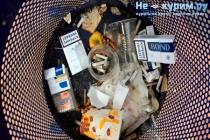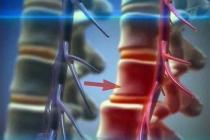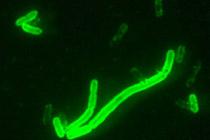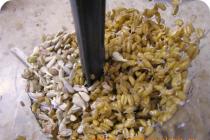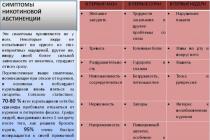Of the fish that are caught in the sea near our shores, representatives of two families - herring and cod fish - have the greatest commercial value.
In addition to several anadromous species that rise to throw eggs from the seas into rivers, most herring are permanent inhabitants of the seas, but for throwing eggs they approach the banks or estuaries of rivers, looking for shallow places with a hard bottom, such as sandbanks.
The herring moves in such dense masses that the sea ripples along the line of its course and the school can be seen from afar. At this time, herring is strenuously pursued by all sorts of predators (Fig. 79), and near the coast, fishermen catch them in huge numbers in distributed nets.
The greatest commercial value is the northern sea herring ( Clupea harengus) - a species that is widespread in the oceans and seas of the northern hemisphere and forms in their expanses a number of subspecies, among which we will name Atlantic, Far Eastern, White Sea, Pechora herring; herring also belongs to the same zoological species - a smaller (up to 20 cm) form, taken in the Baltic Sea and its bays.
The subject of fishing is also smaller species of the same herring family, such as sprat, a species caught in our Baltic and Black seas, as well as tulka, or Caspian sprat ( Clupeonella delicatula), living not only in the Caspian, but also in the Azov and Black seas. And in the Far East, Iwashi, or Pacific sardine, which is somewhat larger in size, is caught.
Often in the trade, these fish go not under their real zoological names, but under the name of the fish in the manner of which they are prepared. For example, under the name of kilka, we sell canned food from small White Sea or Baltic herring, and from the Caspian-Black Sea tulka, and from the Caspian sardine, sometimes from the Kerch anchovy; under the name sprat there is smoked and then drenched with vegetable oil tulka, herring, Astrakhan potbelly, etc.
Of the cod family, cod is of prime commercial importance (Fig. 80). This is a large fish up to 1 m long or more.
Although cod is caught in all the seas of Northern Europe, the amount of fish caught here is negligible compared to the masses that are caught annually near the Lofoten Islands, Newfoundland and our Murmansk coast.
The periodic appearance of cod off the coast and its accumulation near the shoals is not associated with spawning: cod does not need to spawn in the shallows and can spawn in the open sea, since its eggs, which contain a lot of fat, are lighter than water and float on the surface (is there a connection between by this circumstance and the extraordinary fertility of cod even among fish, laying up to 9,000,000 eggs). Cod is a gluttonous predator and comes to shores and shoals for prey, chasing shoals of herring and other smaller fish going to spawn.
In addition to fishing with trawl nets, cod is also harvested using longlines. This tackle carries several thousand fishing hooks, which require a huge amount of bait - various small fish that fishermen have to catch with nets specifically for this purpose.
Haddock (or haddock - Fig. 81) and pollock caught in the same areas are close to cod in structure and lifestyle. Their smaller relative, navaga, is caught in winter with fishing rods and brought frozen into the interior of the country (in the Pacific Ocean, a close to it, but larger, Far Eastern navaga, or vakhnya, is mined).
With the development of trawl fishing, the so-called sea bass, caught in the Barents Sea and sold frozen, has taken a significant place among fish products (Fig. 82). It is a viviparous fish and a very distant relative of the real perch.
The lifespan of different fish species differ significantly. Some exotic fish live no more than a year. Among such fish species as beluga, carp, pike and others, individuals up to a hundred years old and more are recorded. The average life span of the main commercial fish (cod, flounder, etc.) outside the influence of fishing does not exceed thirty years, but under the influence of intensive fishing they usually do not reach their age limit and do not die a natural death, but are caught.
Characteristics of the main commercial fish families
Cod family.Fish of this family live in the seas of the northern hemisphere. They are most common in the North Atlantic Ocean. The main commercial species of the cod family are cod, haddock, pollock, hake, hake, blue whiting, navaga, pollock, pollock, and from cod - burbot... All are characterized by a relatively large head, few bones, and a large fatty liver. Despite the large proportion of the head, the meat yield of almost all cod fish is more than 50% of the total mass.
Chemical composition cod meat is characterized by a low fat content, in most fish of this family it is less than 1% and only in navagiand hakethe share of fat accounts for an average of 1.6 and 2.8%. The average content of crude protein in the meat of most representatives of the cod family ranges from 16 ... 18%.
The gastronomic qualities of cod fish show some dependence on the chemical composition. Have the best taste navagaand hake.
is the most important member of the family in terms of its economic value. It is a large fish, reaching a length of 160 cm, with an average commercial length of 50 cm. It is harvested mainly frozen. Refers to table fish.
Haddockreaches a slightly smaller size than cod. It does not tolerate temperatures below 0 ° C, and the northern border of its habitat lies slightly farther south than that of cod. Haddock tastes noticeably different from cod, its meat is more tender. In some Western European countries, haddock is more valuable than cod.
Codand haddockcan be used in cooking to prepare a large number of dishes. They taste good when boiled, stewed and fried. Fried cod and haddock with various hot sauces are especially good.
Saidalives in the North Atlantic. The usual length is 60 ... 70 cm. Some individuals reach 120 cm and weigh up to 10 kg. Pollock is used the same way. like cod.
Whitingfound off the coast of Europe from the Mediterranean to the Norwegian Sea. It is a relatively small fish, usually 40 ... 45 cm in length. In terms of mass and chemical composition, as well as in taste, whiting is similar to cod and haddock.
Navagait is caught in winter by ryuzhi during the approach to the shores for spawning. The navaga caught under the ice is laid out in a thin layer on ice and frozen. in a natural way, as a rule, uncut. Navaga fried in breadcrumbs is the most delicious dish, which can be prepared from all cod. Merlouse and silver hake are very similar in their nutritional qualities. They taste like navaga. The silver hake has a length of 25 to 40 cm.
Blue whitingit is caught mainly in the Icelandic region, although its distribution area is almost the same as haddock. Blue whiting is a relatively small fish, reaching a length of up to 40 cm. In terms of weight and chemical composition, as well as gastronomic qualities, blue whiting is close to cod and haddock. Blue whiting is caught by trawls.
Saika- small cod. The catches are dominated by individuals 16 ... 28 cm long and weighing 30 ... 110 g. Of all cod fish, this is the most cold-loving fish. Inhabits the eastern part of the Barents Sea and the Kara Sea. Pollock meat is watery and low in protein, so its dietary use is limited.
Pollock- the most numerous, having the greatest commercial value of the cod fish living in the northern part of the Pacific Ocean. Alaska pollock reaches a length of up to 90 cm.The average fishing length is about 40 cm.
Characterizing the value of fish of the cod family, it should be noted that with a relatively low calorie content (60 ... 90 calories per 100 g), as a rule, they belong to protein fish. As a food product, they are good in that many different dishes can be prepared from them. At the same time, it is noted that cod and other fish of this family do not become boring and can be eaten for a long time with the same pleasure, which cannot be said about many types of fatty fish, although they have a very pleasant taste.
The dietary value of cod is also great. Due to its low fat content, cod meat is a valuable source of protein for people prone to overweight. For people above middle age, cod meat is valuable because it contains a lot of methionine, which contributes to the normal metabolism of cholesterol, that is, it prevents the development of atherosclerosis. Of great importance in the processing of cod is the use of the liver, which is characterized by high fat content and the content of fat-soluble vitamins. Natural canned cod liver food is in great demand.
Salmon family. Salmon anadromous and freshwater fish northern hemisphere. They are distributed mainly in the basins of the rivers of the Arctic Ocean, the northern part of the Atlantic and Pacific oceans. Salmonids differ from other fish by the presence of an adipose fin. Are of commercial importance salmon, brown trout, Far Eastern salmonand whitefish... They make up a small proportion of the total fish catch, but the high qualities of salmonids make them an important fishing target.
Most salmon are caught during their spawning run into the rivers. During the upriver movement, they do not feed; all the work of moving upstream is done at the expense of the reserves of fat and protein accumulated in the sea. Therefore, the chemical composition and nutritional value of salmon fish change greatly after entering the river - the content of ox increases and the fat decreases.
Salmonhas the greatest commercial value of all salmonids in the European North. Its juveniles live in the river from one to five years and then slide into the sea, where they spend time until they reach maturity from one to three years. In fruit juice, salmon grows much faster, therefore, from how early it rolled down from the river, its growth will be greater. For example, if she spent five years in the river and one year at sea, then when entering spawning, her weight will be from 1 to 3 kg, if, on the contrary, she rolled into the sea through a head after hatching, then her weight may be more than 20 kg ... The larger the salmon, the higher its fat content. The average weight of caught salmon is from 5 to 15 kg, but there are specimens weighing more than 30 kg and a length of more than 150 cm.
Brown troutfrom salmonhas a brighter body color. The average size of trout is 30 ... 70 cm with a mass of I to 5 kg, but there are individuals weighing up to 20 kg
Far Eastern, or Pacific salmon - chum salmon, pink salmon, chinook salmon, coho salmon, sima and salmon - are of great commercial importance. Far Eastern salmon, as well as salmon, spawn in the upper reaches of rivers, making for this long spawning migrations. During the spawning season, they do not feed. After spawning, due to severe exhaustion and disruption of the vital functions of the body, they die.
Chum salmon and pink salmon have the greatest commercial value and wide distribution in comparison with other species of Far Eastern salmon. Chumdepending on the spawning time, it has two forms - summer and autumn. The commercial length of the summer chum salmon is 58 ... 60 cm, the weight is 2 ... 3 kg, the body length of the autumn chum salmon is 70 ... 75 cm, the weight is 4 ... 5 kg. Chum salmon meat and caviar have high taste. Pink salmon- small salmon... Average body length 45 ... 50 cm, weight 1 ... 1.7 kg.
Sigi- the most numerous in terms of species composition of fish of the salmon family. These include omul, broad, muksun, peled, vendace, etc. Whitefish live in clean water with a high oxygen content. Among whitefish there are checkpoints ( omul, muksun) and freshwater ( peled, wild boar, vendace) forms. Whitefish meat also has good gastronomic properties.
Various food and snack products are prepared from salmon, but, perhaps, lightly salted fish is considered the most delicious. So, for example, lightly salted salmon can be placed in a row with sturgeon caviar. Well-salted pink and chum salmon are not inferior to salmon. Salmon, chum salmon and pink salmon, although they have a pleasant taste when cooked, quickly become boring.
Scorpion family. Scorpionaceae live in the coastal waters of tropical and subtropical seas. In our waters, they are found in the Barents Sea and in the Far East. Of great commercial importance are beak perch and golden sea bass The golden perch is much larger than the beak. The largest specimen of golden perch was 89 cm long and 9 kg in weight. The bulk of the perch caught has a fishing length of 26.50 cm. perchestrawls.
Mass composition of marine perchescharacterized by a relatively low meat yield, usually no more than 50% of the weight of the whole fish. The meat of sea bass is a medium-fat protein (from 2 to 10% fat).
Sea bass can be used to prepare a wide variety of culinary products. Cold smoked beefs and dried perch are in good consumer demand.
Herring family. Herring- the most important object of fishing. In our country, fishing is based on oceanic and Caspian-black-sea herring... Herring is harvested with fixed seines, nets and trawls.
In the North Atlantic and the Barents Sea, mainly one species of herring is caught with several local races. In the western sector of the Atlantic, there are also small numbers of very large shad herring, reaching a length of up to 75 cm and weighing more than 3.5 kg, and anadromous Menhaden herring entering rivers for spawning. Atlanta-Scandinavian herring lives up to 20 ... 25 years. The average commercial length of Atlantic herring is from 25 to 31 cm and weight is from 200 to 500 g.
During the year, the nutritional conditions of herring vary greatly. They have fairly long periods of fasting. Herring have adapted to the alternation of abundance and lack of food, accumulating large reserves of fat in their bodies in summer, which is consumed in winter period... Besides fat, herring can also store a small amount of protein. As a result, the chemical composition of herring is subject to significant seasonal fluctuations. This is reflected in its mass composition.
Herring is one of the fish that can mature in salted form, so the main type of processing is the salting. Lightly salty products have a pleasant taste and aroma. Herring can be used to make good spicy and pickled foods that enjoy great spa
The temperate, subtropical and tropical waters are home to three genera of sardines: sardine, sardinops and sardinella. The most important commercial value is pilchard sardine, or European sardine.
Flounder family. These are marine, inactive, bottom fish with an asymmetrical body strongly compressed from the sides. In most species, the eyes are on the right side of the body. The greatest commercial value are halibuts, sea, yellowfin, yellow-bellied, stellate flounder.
Fishing is carried out with trawls, longlines, fixed nets.
Halibut white-hairedis one of the largest fish in the North Atlantic. Some individuals reach a weight of 300 kg with a length of 4 m. The meat yield of halibuts is greater than that of flounders and amounts to 65% of the animal's weight. Halibut meat has a very pleasant taste and is used to prepare a wide variety of products. In small specimens of halibuts, the meat is more tender than in large ones, and the fat content in the meat of halibuts increases with age. In cooking, halibut is used to prepare first and second courses. Due to the dense meat consistency halibutsuitable for cooking and roasting. Halibut jellied meat has a very good taste.
Blue-bark or black halibut has a smaller size than white-haired. Some specimens reach a length of 120 cm. The average commercial size of blue-horned halibut is 45 ... 65 cm with a mass of 1 to 5 kg.
By chemical composition, blue halibutnoticeably different from white-haired - its meat is much fatter, but poorer in protein. Due to its higher fat content, blue-bark halibut is used to prepare tasty and nutritious smoked products that can be placed on a par with stellate sturgeon balyk.
Sea flounderdiffers in a rather large meat yield - up to 70% of the total mass. However, the nutritional value of flounder is not very high, as the fat and protein content of its meat is low. Nevertheless, sea flounder is in demand among the population due to its pleasant taste, especially when fried.
Family catfish. This family is represented in the North Atlantic by three species: spotted, striped and blue catfish. They do not form commercial aggregations and are caught as by-catch together with other bottom fish.
Spotted catfish is the most chained in its taste of all the catfish. This is a large fish with an average size of 90 ... 100 cm and a mass of about 8 kg.
Striped catfish inhabits almost the entire North Atlantic. Its dimensions are slightly smaller than that of the spotted - the average length is from 40 to 70 cm with a mass of 0.5 ... 4 kg.
The meat yield of the spotted catfish is slightly higher (63%) than that of the striped catfish (57%). The chemical composition of both catfish is similar and is characterized by an average fat content (from 2 to 8%) and a relatively low protein content (about 16%). The most delicious products from spotted and striped catfish are obtained by hot smoking. In this case, the lack of protein is not only not felt, but, on the contrary, gives the product a more delicate consistency.
Blue catfish(widow) lives in the more northern regions in comparison with the other two species. Its meat is characterized by a high water content and a low protein content. This makes its meat flabby, watery and not very suitable for cooking. food products... The main fat reserve in blue catfish is in the liver, the fat content of which can reach 40%.
Mackerel family. Mackerels live in the warm temperate waters of the Atlantic, Pacific and Indian oceans. These are marine pelagic schooling fish. The most important commercial value is common(atlantic) mackerelinhabiting the North Atlantic Ocean, as well as the Mediterranean, Black, North and Baltic Seas. The average length of the Atlantic mackerel is 25 ... 35 cm. The Atlantic mackerel makes seasonal migrations along the coasts of America and Europe. Approaching the shores and moving away from them is associated with changes in water temperature, wind direction and currents. Mackerel is caught with trawls.
Common mackerel.
Meat mackerelfatty, tasty. It is suitable for preparing a wide range of food and culinary products. Smoked mackerel has a very good taste. When salted, it ripens well and can serve as a pleasant snack.
Fat mackerelvery quickly oxidized in air, therefore, when storing it in ice cream, it is necessary to efficiently glaze or use other protective coatings.
Horse mackerel family... Horse mackerel are schooling pelagic fish that live in the tropical and temperate regions of the Atlantic, Pacific and Indian Oceans. The body of horse mackerel is compressed from the sides, covered with small scales. The caudal peduncle is thin, the lateral line scales form bony scutes ("bugs"), which create inconvenience when cutting. The length of horse mackerel is up to 50 cm.
Horse mackerel living in the Atlantic Ocean off the coast of Europe and Africa has the greatest commercial value. They catch horse mackerel with set, purse seines and trawls.
Horse mackerelis a fairly valuable fish, suitable for the preparation of various snack products. It is mainly used for the preparation of canned food and smoked products. When boiled, its meat is somewhat dry, has a slight specific sour taste. Like mackerel, horse mackerel fat oxidizes very quickly.
Tuna family. Widespread in tropical and subtropical Atlantic, Pacific and Indian Oceans, although some tuna pitchforks are caught in colder waters. Tunaare large, schooling, pelagic fish that live mainly in the open ocean. Tuna can reach a length of up to 3 m and a weight of about 600 kg. Common, or bluefin tuna, longfin tuna, common bigeye tuna and small tuna - striped, mackerel and spotted tuna are of the greatest commercial value. Tuna are hunted with flowing longlines, purse seines.
Tuna meat has the highest protein content among all fish - 22..26%. In this respect, it can be equated only to the eggs of certain species of commercial fish. The fat content of meat ranges from a fraction of a percent to 19%.
Tuna meat can be used for the preparation of various products - good canned food is made from it, in culinary products it resembles pork or beef, in particular, very tasty boiled pork is prepared from it. At the same time, tuna meat can cause quite severe poisoning if the fish is not processed immediately after catching. In this case, the meat can quickly deteriorate and become poisonous. It should also be noted that the meat of large tuna may have a higher mercury content. Tuna liver contains up to 30% fat and is very rich in vitamins L and D.
Smelt family.Smelt inhabit sea and fresh water bodies of the northern parts of the Atlantic, Pacific and Arctic oceans. Among the smelt, some spend their whole life in the sea (capelin), others are anadromous or semi-anadromous. The greatest commercial value of the smelt is capelin... They catch capelin with midwater trawls, coastal to purse seines, and fixed traps. The average length of individuals prevailing in the catches is 13 ... 15 cm, with a commercial length of capelin of at least 11 cm. The fat content of summer-autumn capelin meat ranges from 16 to 29%. Its protein content at this time is the lowest in comparison with other fishing seasons (12.5%), but relative to lean meat it is the highest - 20 parts of protein per 100 parts of water. Summer and winter capelin have a fairly dense meat and are suitable for preparing a variety of products. The capelin bones are slightly mineralized and easily softened by heat treatment. Delicious canned food "Smoked capelin in oil" is made from capelin, various culinary products and preserves.
We have a number of the richest reservoirs in terms of fish resources. Even in the pre-war period, with far from enough attention to the country's natural resources, Russia occupied one of the first places in fishing, namely, in terms of the value of fish catch, it was in second place, and in terms of the total amount of catch, in first.
The world catch of fish before the war of 1914 was 9 608.2 million kg, and the catch in the main countries was:

World post-war catches have declined in many countries. However, the total production increased and was estimated in 1923 at about 800 million dollars. For individual countries, the estimated catch is:

Former. USSR in connection with civil war In 1923, he took the sixth place in terms of the value of the catch instead of the second, but already in 1927, in terms of the cost of the finished product, he again moved to second place, all the time increasing production, and at the same time improving the quality of products. Search engines and others research work, the organization of fishing on a collective basis, the mechanization of fishing, the development of the manufacturing industry, etc., have greatly raised the quantitative and qualitative aspect of our fishing industry, and now we are in the first place in fishing.
We have the following fishing areas.
Caspian region, which includes, in addition to the Caspian Sea, the rivers: Volga, Ural, Terek, and Kura. This area supplies half of all fish caught within Russia, namely over 690 million kg. The fish stocks of the Caspian Sea are the main base of our fishery. The oldest fishery here is the sturgeon fishery - the red cattle. Catch: sterlet, sturgeon, beluga, stellate sturgeon, thorn. From the so-called "small" fish (mainly cyprinids, as well as perch, including salmon and whitefish), the following are caught: roach (Rutilus rutilus caspius), carp (Cyprinus caprio), common pike perch (Lucioperca lucioperca) and sea (Lucioperca marina) , bream (Abramis brama), catfish (Silurus glanis), pike (Esox lucius). These are the fish caught in the greatest quantity. Further, a number of highly valuable small fish are caught: Caspian salmon (Salmo truttalabrax), white fish (Stenodus leuciclithys), shemaya (Alburnus chalcoides), kutum (Rutilus frisii kutum) and a number of less valuable: silver bream, or ram (Blicca bjoerk Abramis ballerus), white-eyed (Abramis sapa), rudd (Scardinius erythrophthalmus), sabrefish (Pelecus cultratus), etc. Fishing for the Caspian lamprey (Caspiomyzon wagneri) is becoming increasingly important. Despite the very intensive, moreover, mechanized fishing of small fish, stocks of fish such as roach, bream, carp, the reduction is imperceptible.
Herring fishing is of the greatest importance in the Caspian. Here the herring is different than in the Atlantic Ocean or the White Sea; it does not belong to the genus Harengus, but Caspialosa. There are more than 10 species of them The most important in commercial terms are the following: 1) Caspian pusanok (Caspialosa caspia), 2) Volga herring (Caspialosa volgensis), 3) black-backed, betonka, or hall (Caspialosa kessleri), 4) Dolgan, or Mangyshlak, herring (Caspialosa brashnikowi), B) astrabad herring (Caspialosa leucoccphala). Herring fishing developed in the Caspian only at the end of the last century and the beginning of the present century, it increased rapidly, and this increase was not the result of overfishing, but more rational and intensive exploitation.
Herring fishing in the Caspian Sea has been provided for many years, and small catches of herring in some years are explained by random reasons. At present, the Caspian fishery is mechanized and raised to the proper height.
Of particular importance in the Caspian region is the production of black caviar, which is a valuable product for export to foreign markets.
Fisheries are mainly located in the mouths of the Volga, with a tendency to move to the sea, and in the mouths of the Kura River. In Astrakhan there is an exemplary ichthyological station for scientific development of the issues of the Caspian fishery. Another station is located on the Kura River. The third is in Krasnovodsk.
The Pacific, or Far Eastern, region covers the coastal areas of the seas of Japan, Okhotsk, Kamchatka and Anadyr, as well as the rivers flowing here, in the first place among which is the Amur. Here Russian fishing emerged recently: only from 1904-1906. it made great strides and gained national importance. In just 10 years, the catch increased from 16 to 163 million kg in 1913, and half of the catch was taken to Japan. The main catch of fish in the Far Eastern region is anadromous salmon, belonging to the genus Oncorhynchus: chum salmon (Oncorhynchus keta), pink salmon (Oncorhynchus gorbuscha), red salmon (Oncorhynchus nerca), kizuch (Oncorhynchus kychawschuschutsch) and chinook The most important were the first two types. Excessive catch of salmon during their movement up the rivers for spawning has already had a disastrous effect: the course of fish has become less correct, many rivers and even entire regions have become scarce with it, the number of chum salmon, which not only itself served as an object of import to European Russia, but also its caviar decreased greatly.
Among the marine fisheries in the seas of the Far East, in the first place was the fishery of the Pacific herring (Clupea pallasii), exported to Japan for fertilization.
In addition, relatively small numbers of navaga (Gadus navaga), cod (Gadus callarias), mackerel and flounder were caught. Before the war, fishing with trawlers both in the Sea of \u200b\u200bOkhotsk and in the oceans revealed colossal stocks of bottom fish, mainly cod and flounder (Gadidae and Pleuronectidae), no less than in the Atlantic Ocean.
Far Eastern fisheries have a great future. There is a scientific field station in Vladivostok to serve it.
Rivers and lakes of the European part of Russia, which gave 131 million kg of fish before the war. All river and lake waters of Russia belong to this area.
The area of \u200b\u200blarge lakes is especially important: Ladoga, Onega, Chudskoe, Pskov, Ilmen and Velozero.
The most important commercial fish here was smelt, or lake smelt (Osmerus eperlanus sprinchus). Despite the extremely intensive catch, the amount of smelt did not decrease significantly. In addition, the following are caught here: perch (Perca fluviatilis), roach (Rutilus rutilus), ruff (Acerinacernua), pike perch (Lucioperca lucioperca), bream (Abramis brama), lake salmon, char (Salvelinus alpinus), taimen (Salmo trutta), various whitefish (Coregonus), vendace (Coregonus albula).
Another, also important area, is the upper reaches of the Volga, Don and Dnieper, where up to 50 million kg of local fish were caught, including sterlet (Acipenser ruthenus).
Aral region, covering, in addition to the Aral Sea, the Syr-Darya and Amu-Darya rivers, as well as the Zeravshan, Chu and Issyk-Kul lake. Here, the trades emerged recently, only 60 years ago, when the exiled Ural Cossacks were resettled by the tsarist government along the course of the Syr-Darya River. Until the Orenburg-Tashkent railway was built, the industry developed very poorly due to the lack of sales. Lake Issyk-Kul is still in this position. With the construction of the road, production in the field has greatly increased.
The main commercial fish of the Aral Sea are carp and bream (Cyprinus carpio and Abramis brama). In addition, catfish (Silurus glanis) and Aral barbel (Barbus brachycephalus) are caught, as well as shemai (Alburnus chalcoides) and thorns (Acipenser nudiventris). The fish of the Aral Sea is extremely fat.
On the shores of the Aral Sea, large fisheries of the Astrakhan type arose and both river and sea fishing were restored. At present, catch has increased greatly due to the mechanization of fishing and its collectivization.
In Issyk-Kul, carp, chebak (Leuciscus schmidti), “Issyk-Kul herring” (Leuciscus bergi) and other less important fish are caught. Sales are local only.
Rivers and lakes of Siberia. This region is extremely rich in fish, and, moreover, very valuable (whitefish - genus Coregonus; sturgeon - Acipenseridaen cyprinids). Ho off-road, extremely sparse population in the most fishy lower reaches and the primitive nature of fishing made fishing here artisanal. Fishing for omul (Coregonus autumnalis) in Baikal was of great importance.
Region Black Sea-Azov. The Azov Sea is especially rich due to its shallow water, freshened by many rivers and richness of organic life. On the example of the Sea of \u200b\u200bAzov, we see the result of predatory fishing and a change in the regime of rivers flowing, thanks to structures, which is expressed in the extreme depletion of the basin. A hundred years ago, up to 82 million kg of fish were caught here, mainly sturgeon (Acipenseridae), pike perch (Lucioperca lucioperca), bream (Abramis brama) and carp (Cyprinus carpio). About 36-40 years ago, fishing began to decline, and in 1913 only 33.6 million kg were harvested, and of which almost 15 million kg fell on anchovy, or anchovy (Engraulis encrassicholus). Recently it became an object of fishing, and sturgeon fishing fell to 650 thousand kg.
In the same way, the fishing industry in the Black Sea fell, which in itself, due to the depth off the coast and other reasons, is not very convenient for fishing. Over the past 35-40 years before the war, fishing fell here from 45 to 13 million kg.
However, the launch of fishing during the war and the first years of the revolution restored fish stocks in the Black Sea-Azov region and increased the total catch here to 49 million kg in 1925, to 56 million kg in 1926 and to 65 million kg in 1927. The sturgeon catch has increased to 1.3 million kg, while pike perch and bream now account for 65 and 70% of the total catch.
The main fish caught in the Black Sea-Azov region: sturgeon (Acipenser guldenstadti), stellate sturgeon (Acipenser stellatus), beluga (Huso-huso), herring (Caspialosa pontica, Caspialosa normanni, Caspialosa tanaica and Caspialosa meotlea), nuta spiny flounder, glossa (Pleuronectes luscus), mackerel (Scomber scomber), sultan (Mullus barbatus), mullet (Mugil auratus and other species), gobies (Cobiidae).
The Gulf of Finland. Here, the main object of fishing is the herring, known as the herring (Clupeaharengus membras), which is distinguished by its small size (from 15 to 23 cm) and the sprat (Clupea sprattus). Eel (Anguilla anguilla) is also caught here.
Finally, paradoxical as it may seem, the last place was occupied for a long time by the Arctic-Belomorsk region, covering the shores of the Arctic Ocean with the White Sea and with rivers flowing into it. This is really very paradoxical, for. As scientific fishing expeditions have shown, in the waters of Murman, Kanin Nos and Kolguev Island, where the warm Gulfstrom branch passes, there are inexhaustible stocks of cod (Gadidae), herring (Clupeidae) and flounder (Pleuronectidae) fish.
In addition, large quantities of chain salmon (Salmo salar) are caught in the rivers of this region. Previously, the reasons for the poor development of the fishery were: remoteness, impassable roads, poor population, poor technical equipment. Before the revolution, the data of our expeditions were used by foreigners, mainly the British, who came here with trawlers. Their fishing quickly overtook the Russian coastal fishing. Before the war of 1914, the foreign catch in the Russian waters of the Arctic-Belomorsky region was equal to 80% of the total catch of this region. This explains the issuance of the decree (March 24, 1921), prohibiting foreigners from fishing closer than a 12-mile strip along the entire northern coast.
After the revolution, fishing in the Arctic-Belomorsky region, especially in Murman, took a completely different turn. A railway and Russian trawlers appeared here, the entire fishing fleet is motorized, the fishing industry is technically equipped, a naval base in Murmansk is equipped. Catches have increased dramatically.
However, despite our wealth of fish, the amount of fish caught still does not meet the greatly increased demand of the population for fish. In addition, the preparation of fish for future use (salt, smoking and canning) in our country was much lower than in Europe. In this regard, a radical socialist reconstruction of the fishing industry, fishing and fishing industry on the basis of industrialization is being carried out, state farms and collective farms of fishermen are being organized. The economy is based on a planned start - five-year and long-term plans, which provide not only an increase in catch based on mechanization, rationalization and development of new spaces, but also an increase in fish stocks through properly organized scientifically grounded fishing, reclamation of fish lands and fish farming. Attention is drawn to the quality of products and the widespread use of waste. During the past five-year period, many trawlers have been built, speed boats have been introduced, new methods of mechanical fishing have been introduced, the production of canned food has significantly increased in quality and quantity, etc.
Liked? \u003d\u003e
Man learned to fish at the dawn of his civilization. Not surprisingly, different types of fish have occupied one of the most important places in his diet, competing in terms of consumption with such categories of products as, and. And for residents of coastal cities around the world, marine life is the basis of the diet.
At the same time, it is important that each geographical area has its own common and rare species of fish. And they all differ in their nutritional properties and effects on the human body. Moreover, these differences are often even greater than between fish products and, for example, beef. Therefore, the properties of the most common species and groups are worth knowing just to control the situation.
What types of fish are found in modern aquatic life? The most common classification of fish species is their division into marine and freshwater. We will consider them first of all.
Types of marine fish
Various types of marine fish are considered by nutritionists to be the most useful: their meat contains a huge amount of vitamins, they are richest in phosphorus and are much less bony.
It is interesting that the inhabitants of the salt waters fatten much higher quality and healthier fat than their freshwater counterparts. It has less cholesterol and more omega-3 fatty acids, which are essential for the brain.
But alas, the inhabitants of the mainland hinterland can get fresh sea \u200b\u200bfish very problematic, and even a banal freezing leads to disturbances in the structure of protein and a decrease in the usefulness of the entire fish product.
Freshwater fish species
These groups cannot boast of such high-quality fat, but they are also sources of substances that normalize the functioning of the heart, digestive tract and the state of the outer layers of the body.
In addition, everyone knows the luxurious tastes that some fish have. freshwater species:, grayling, carp. Perhaps the mere pleasure of using them may be more significant than the benefits for the body.
The most valuable fish groups
Well, it is worth discussing separately those species and names of fish that are the most famous representatives of the ichthyofauna and popular guests on our table.
The classification of commercial fish considers the following groups to be the most valuable:
- carp - one of the most common in stores in our country. Their meat is tender, they have few bones, and are almost always quite fat. It is important that regularly eating carp fish species means to help improve the functioning of the digestive system and normalize the functioning of the heart.
- herring - well-known tulka, sardine and others like them. Eating fish of the herring family has a positive effect on the condition of cardio-vascular system and is a good prevention of diabetes. And in the sprat, scientists have found all the vitamins necessary for a person.
However, salted herring fish has contraindications: it is not recommended for hypertensive patients and those suffering from gout and kidney disease.
- red -, - not only are they incredibly tasty, they also improve vision and the condition of the organs of the circulatory system. Red fish species are often prescribed to the elderly as a means of slowing aging.
- mackerel - species considered to be among the most useful. This includes mackerel. Eating them helps to activate mental activity. However, large members of this family tend to accumulate mercury in the body, so mackerel fish such as large tuna and mackerel are not recommended to be consumed in large quantities.
- cod - famous



